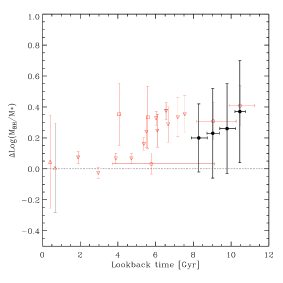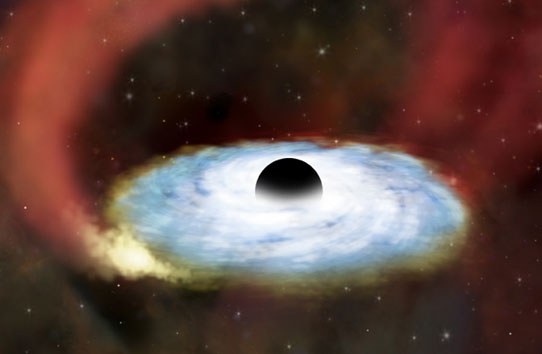Black Holes and their Galaxies: News from a Cosmic Neighbourhood
21.01.2010 —
Among astronomers it is considered certain that huge Black Holes of millions of solar masses reside in the centre of practically every galaxy. It is still unclear however as to what extent the chronological development of the galaxies and their Black Holes in the centre mutually influence one another. A research project under the aegis of Andrea Merloni at the Excellence Cluster Universe of the TU München brought forward new findings in this area.
After Albert Einstein had formulated his general theory of relativity, Black Holes existed merely as a hypothetical possibility. In the meantime astrophysicists are convinced that these objects are extremely common in the Universe. Yes, they can even be found in our Milky Way: Black Holes, the most exotic of all cosmic objects have belonged to the standard repertoire of astrophysical research for a long time now. Thanks to the extremely sharp eyes of the Hubble Space Telescope, in the past 20 years it has been established that Black Holes do not just drift through the galaxies as the relatively low-mass residue of stellar explosions (supernovae), but also as huge gravitational centres that make up the centres of most galaxies.
Figure 1: Example of one of the 89 galaxies observed. The panel on the left shows the galaxy as it is observed in different wavelengths (colours). The image on the right shows the total energy received at the different wavelengths and how the contributions from the host galaxy (green line) and black hole (purple line) can be distinguished.
Such central holes reach between several million and several billion solar masses, which makes them appear veritably gigantic compared to the diminutive stellar residues. In earlier cosmic epochs, as a rule, the massive Black Holes were surrounded by dense discs from the interstellar material, that is gas and dust. Such rapidly rotating accretion discs heat up strongly due to the inner friction, so that they glow extremely brightly, brighter than all the stars of the galaxy together. Stellar systems that display this effect are called active galaxies.
As already shown in earlier analyses of galaxies in our cosmic neighbourhood, there is a close correlation between the masses of the central Black Holes and several physical characteristics of the galaxies’ centres. The total mass of the stars of the galactic centre and the mass of the Black Hole appear in an approximately fixed ratio. Researchers have assumed for a long time that this mass ratio is possibly subject to a cosmic evolution. A collaboration of international researchers with Andrea Merloni from the Munich Excellence Cluster Universe among them as the leading scientist has now succeeded in founding this hypothesis on solid ground.
The researchers drew on data from the international zCOSMOS observational campaign for their analyses, in whose framework more than 10,000 both active and inactive galaxies were measured spectroscopically. Thanks to the hitherto unmatched data diversity from the zCOSMOS survey, researchers succeeded in extracting from the received radiation the respective contributions from the active nucleus (the growing black holes) and the surrounding region. In addition, a new technique was developed with whose help it was possible to determine the masses of the surrounding stars from the colour distribution of the galaxy (spectral energy distribution). The researchers „weighed“ the Black Holes with the help of emission lines produced in the accretion discs.
Figure 2: This graph shows different measurements of the scaling relation between black hole mass and the mass of the host galaxy over time. A clear trend can be inferred: For a given galaxy size, Black Holes in the past were more massive.
The measurements of 89 active galaxies revealed that the mass ratios between the Black Holes and the stars in the galactic centres 10 billion years ago were on average three times higher than is the case today in our cosmic environment. A look into the deep past of the Universe is possible because the light of those galaxies had to make a journey of 10 billion years in order to reach the earth. As the growth of Black Holes depends on the amount of available „fuel“, that is on the stars and the interstellar gas in their environment, the researchers deduct from their findings that the active galaxies of the early Universe are characterized by a particularly high rate of star formation.
Nevertheless, the scientists interpret their results with a due degree of caution. „Our observation results leave open how the growth of Black Holes takes place in detail“, Andrea Merloni says. „It’s still possible that the mass ratio observed today between the Black Holes and the galactic centres has just materialized a relatively short time ago: the Black Holes could have gone through individual bursts in growth in the course of the past few billion years and their masses have adjusted to the current values erratically.“ In order to decide this, the scientists require considerably more observation data.
The detailed results of the work were published 1 January 2010 in the renowned Astrophysical Journal (Merloni et al, 2010, “On the Cosmic Evolution of the Scaling Relations between Black Holes and their Host Galaxies: Broad Line AGN in the zCOSMOS Survey”, ApJ, 708, 137).








